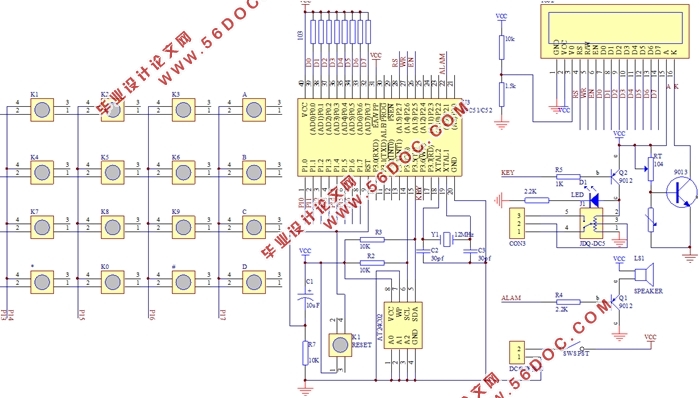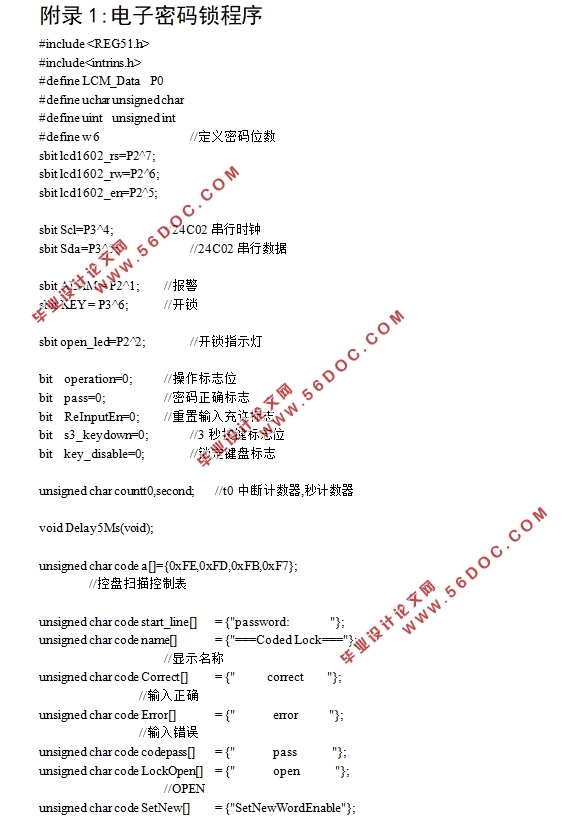基于单片机的电子密码锁设计(附程序清单,电路图)(任务书,开题报告,外文翻译,论文15000字,程序清单,电路图)
摘要
随着社会信息化的不断发展,信息如何保密便成为日益凸显的话题,在各种产品日益电子化的现在,电子密码锁应运而生,并以其方便易用同时安全性高的特性逐渐占有了属于自己的市场。
本课题提供了一种基于单片机的电子密码锁的设计思路,以STC89C52RC单片机为控制核心,通过EEPROM存储器芯片实现密码的掉电保存,利用4*4矩阵键盘输入密码,配合LCD显示屏显示各项提示来完成人机交互。为保证电子密码锁的安全性,本设计还提供了声光报警功能,在密码输错超过上限后锁定密码锁并报警。此外,为方便用户随时更改密码,系统配有复位电路,配合修改密码按键更换用户密码。
本设计成本低廉且易于模块化组装生产,适用于宾馆、住宅、办公室等对安全性与便捷性有一定需求的用锁场所,值得推广。
关键词:单片机;密码锁;掉电存储;LCD显示
Abstract
With the continuous development of information society, how to keep our information in security becomes to an increasingly mentioned topic, with every production becoming more and more electronic, electronic locks came into being, and its features of easy usingwith safety gradually possess their own market.
This paper provides a single-chip design based on the idea of electronic locks with STC89C52RC microcontroller core, containing a power-down password saving via EEPROM memory chip with a 4 * 4 matrix keyboard to enter a password, and the LCD display shows the prompts to complete the human-computer interaction. To ensure the security of electronic locks, this design also provides a sound together with light alarm in the over-input wrong password condition. In addition, for the convenience of the user to change the password at any time, this system has a system reset circuit with the Change Password button to replace the user's password.
This design is cheap in cost and easy to be modularizing produced, it suits such condition like hotel, home and office that needs security and convenience to some extent, and the worth promoting.
Keywords: SCM;lock;Power-down storage;LCD display



目录
第1章 绪论 1
1.1 国内外研究综述 1
1.2 选题的目的和意义 2
第二章 总体方案 3
2.1 设计要求 3
2.2 系统方案比较 3
第3章 硬件选用 5
3.1 单片机芯片选择 5
3.1.1 单片机芯片比较 5
3.1.2 STC89C52RC芯片介绍 5
3.2 AT24C02芯片 7
3.3 键盘输入方案比较 8
3.4 显示模块 10
第4章 硬件电路设计 11
4.1 系统结构框图 11
4.2 主控模块 12
4.2 密码存储模块电路 13
4.3 显示模块电路 13
4.4 供电模块电路 14
5.1 Keil uVision4介绍 15
5.2 系统程序流程设计 15
5.3 各模块程序设计 16
5.3.1 初始化程序设计 16
5.3.2 键盘扫描子程序设计 17
5.3.3 密码修改子程序 18
5.3.4 开锁子程序 19
第6章 系统仿真及硬件测试分析 20
6.1 系统仿真 20
6.2 硬件测试 22
6.3 硬件的环保与经济性分析 26
第7章 结论 27
致谢 28
参考文献 29
|







